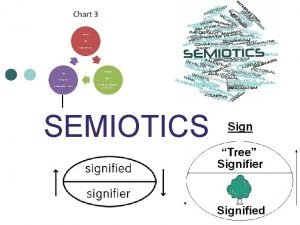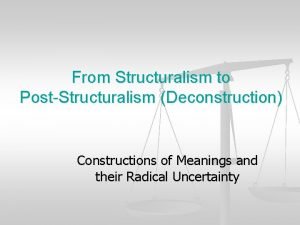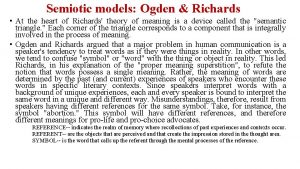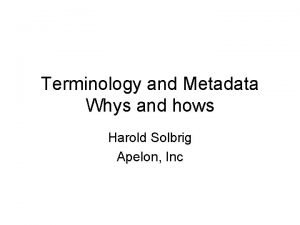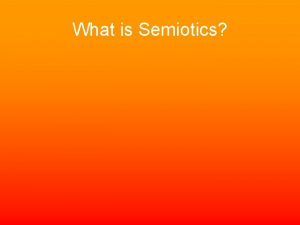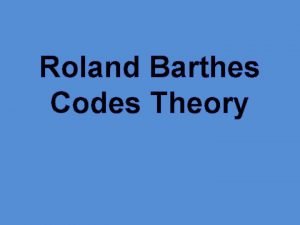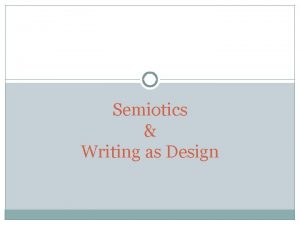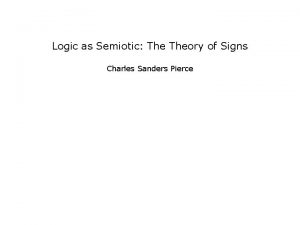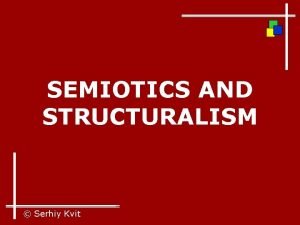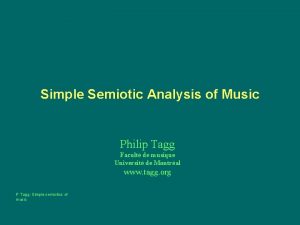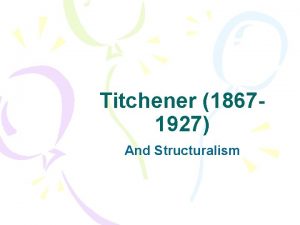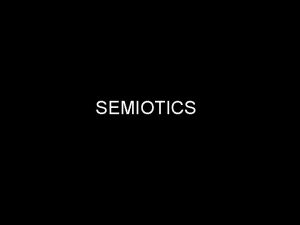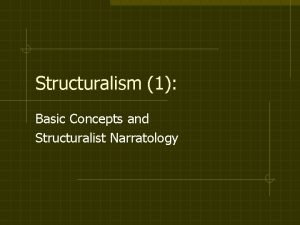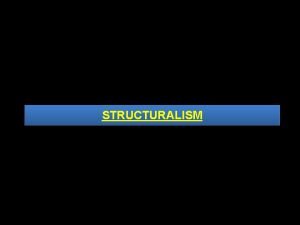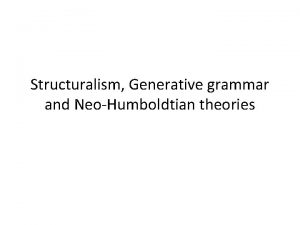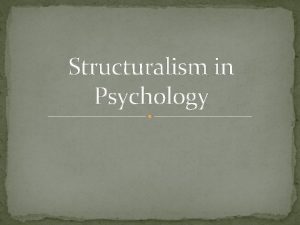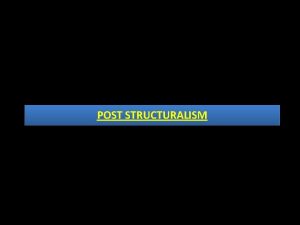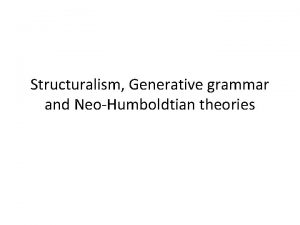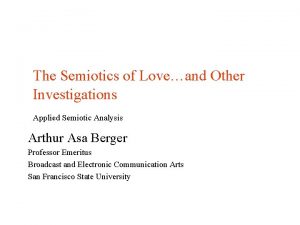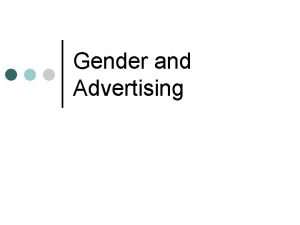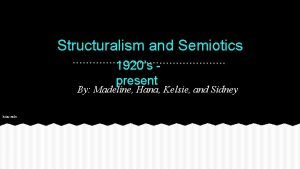z Semiotics Structuralism z Definition Semiotic semiology The


















- Slides: 18

z Semiotics Structuralism

z Definition § Semiotic / semiology => The study of sign and sign-using behavior § a domain of investigation that explores the nature and function of signs as well as the systems and processes underlying signification, expression, representation, and communication. § Semiotic = semeion (Greek)

z Why? Humans are homo-significans (meaning-maker) We make meanings through our creation and interpretation of ‘sign’ Sign takes the form of words, images, sounds, flavors, acts or objects Anything can be a sign as long as someone interprets it as “signifying something” referring to or standing for something other than itself Charles Sander Pierce declares 'Nothing is a sign unless it is interpreted as a sign'

z Here, these guys do it better.

z Characteristic of sign Arbitrariness Sign is arbitrary because there is no inherent, essential, 'transparent', self-evident or 'natural' connection between the signifier and the signified - between the sound or shape of a word and the concept to which it refers Differential Sign has differentiation because a sign stands for its own role, without interference from other signs. The word “d-o-g” resembles an animal called dog, because it is different from animal “c-a-t”

z Saussure’s Concept the arbitrariness of the sign as the first principle of semiology, specifically, the arbitrariness of the link between the signifier and the signified Saussure’s semiotics concept is distinction between two inseparable components of a sign: - the signifier (the form which sign takes) which in language is a set of speech sounds or marks, - the signified which is the concept it represents behind the sign

z Saussure’s Concept § a sign must have both a signifier and a signified, we cannot have a totally meaningless signifier or a completely formless signified § A sign is a recognizable combination of a signifier with a particular signified because sign is the result of association of the signifier and the signified § Here let’s see it again

z Semiotic in Literary Studies § Semiotics represents a range of studies in art, literature, anthropology and the mass media rather than an independent academic discipline § Those involved in semiotics include linguists, philosophers, psychologists, sociologists, anthropologists, literary, aesthetic and media theorists, psychoanalysts and educationalists

z Semiotic in Literary Studies § Semiotic literary criticism, also called literary semiotics, is the approach to literary criticism informed by theory of signs or semiotics § Literary semiotics can be seen as a branch of the general science of signs that studies a particular group of texts within verbal texts in general

z What is the Structuralist Perspective? § Studies the systems of relationships that are embedded in words and items, “and shows us the ways in which we think” (Guerin 369). § Acknowledges the arbitrariness of assigning certain series of letters to represent specific ideas. § Focuses on the opposites that often appear in literary constructs. § The sequence of events from beginning to end § The rearrangement of the narrative to build suspense or for aesthetic effects § Flashbacks § Unequal treatment of time § Shifts in viewpoints or speakers

A Checklist of Structuralist Critical Questions z 1. What are the elements of the work – words, stanzas, chapters, parts, for example – and how can these be seen as revealing “difference”? 2. How do the characters, narrators, speakers, or other voices heard in the work reveal difference? 3. How do the elements of the work’s plot or overall action suggest a meaningful pattern? What changes, adjustments, transformations, shifts of tone, attitude, behavior, or feeling do you find? 4. How are the work’s primary images and events related to one another? What elements of differentiation exist, and what do they signify? 5. What system of relations could be used to link this work with others of its kind? 6. What system of relations could be used to link this work with others of its kind? What system of relations could be used to link this work with different kinds of things with which it shared some similarities? (Di. Yanni 1585)

z Barthes’ Order of Signification Divided into: Denotation, Connotation, and Myth He develops this module base on Saussurean concept of studying signs denotation and connotation are terms describing the relationship between the signifier and it’s signified, and an analytic distinction is made between two types of signified: a denotative signified and a connotative signified Meaning includes both denotation and connotation

z Denotation § Denotation tends to be described as the definitional, “literal, ” “obvious, ” or “commonsense” meaning of a sign § the denotative meaning is what the dictionary attempts to provide § Denotation is meaning of a sign in first level signification

z Connotation is used to refer to the socio-cultural and 'personal' associations (ideological, emotional etc. ) of the sign Connotation can be referred as meaning of a sign in second level signification, higher than denotation meaning Connotations are not purely 'personal' meanings - they are determined by the codes to which the interpreter has access Cultural codes provide a connotational framework since they are 'organized around key oppositions and equations', each term being 'aligned with a cluster of symbolic attitude

z Myths were the dominant ideologies of our time Barthes argues that the orders of signification called denotation and connotation combine to produce ideology which has been described as a third order of signification Myths serve the ideological function of naturalization. Their function is to naturalize the cultural - in other words, to make dominant cultural and historical values, attitudes and beliefs seem entirely 'natural', 'normal', self-evident, timeless, obvious 'common-sense' - and thus objective and 'true' reflections of 'the way things are'

z Barthes puts it this way…

z …and this way… These guys put it this way…

z A Review of Structuralism § Language is primary means of signification § Signification is how we achieve meaning through linguistic signs and other § § symbols Language comprises its own rule-governed system to achieve meaning Language is not the only sign system Act of reading is a cultural and social practice that contains its own codes Meaning in a text resides in these codes § Reader has mastered codes before he/she ever picks up the text § Proper study of literature is inquiry into conditions surrounding the act of interpretation itself, not the investigation of the text § Structuralists seek to discover the overall system (langue) that accounts for the individual interpretation (parole)
 Signifier and signified
Signifier and signified Logocentrism
Logocentrism Semiotic landscape examples
Semiotic landscape examples Ogden richards triangle of meaning
Ogden richards triangle of meaning What is myth in semiotics
What is myth in semiotics Julia garber
Julia garber Semiotic triangle
Semiotic triangle Saussure dyadic model
Saussure dyadic model Cultural code barthes
Cultural code barthes Types of media codes
Types of media codes Nonton paw patrol the movie 2021
Nonton paw patrol the movie 2021 Semiotics
Semiotics Semiotics
Semiotics Semiotics exercise
Semiotics exercise Semiotics
Semiotics Anaphone definition
Anaphone definition Greg rowland semiotics
Greg rowland semiotics Wilhelm wundt school of thought
Wilhelm wundt school of thought What is economic structuralism
What is economic structuralism
